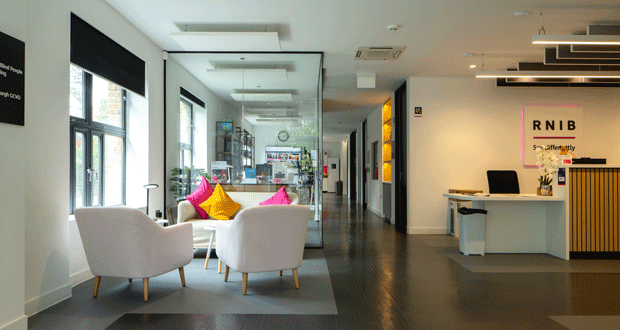The Royal National Institute of Blind People (RNIB) has officially opened its new London hub, The Grimaldi Building, situated on Pentonville Road in Islington. It is the first building in the UK incorporating innovations for those living with sight loss, alongside implementation of the BSI PAS 6493 ‘Design for the Mind – Neurodiversity and the Built Environment’ design guidance, while also meeting current good practice for wider accessibility and inclusion.
The newly refurbished building created by Buro Happold and Kay Elliott, has been designed to offer a modern, flexible and accessible facility for customers, patients, volunteers, supporters and staff.
Bringing together a number of key RNIB services, facilities at The Grimaldi Building include: The Low Vision Service assessment clinics; Products for Life store; usability lab space designed to imitate an everyday ‘living room’ showcasing key everyday adaptations; heritage area; ‘Talking Books’ recording studios; RNIB Connect Radio broadcast studio; a multi-faith room; serenity space for people experiencing sensory overload or stress; and amenities for guide dogs.
The building seeks to create a truly inclusive design for all those who occupy it, with key features including:
- Visually contrasting key surfaces including floors, walls and furniture, including a clear, colour coded, tactile signage system with Braille and embossed text and symbols.
- NaviLens app points so that blind and partially sighted people can also access and locate information and interact with the environment around them. By scanning the code with a mobile phone camera through the app, visitors hear an audio description of the immediate or surrounding area, helping people locate information and points of interest and advising who is approaching them.
- An embossed vinyl flare path indicating the main circulation around each floor, to aid wayfinding and navigation; this circuit-route also allows fire escape stairs and tea points on each floor to be more easily identified by people with sight loss.
- A pioneering approach to lighting with fully controllable lighting for both intensity and colour temperature on each bank of desks and in meeting rooms, giving adjustability over the lighting to suit individual and/or group preferences.
- Acoustics to reduce unwanted noise throughout, providing a comfortable and audibly legible environment across the floors, with more detailed attention given to meeting rooms, the serenity and multi faith spaces, and technical areas such as the recording and broadcast studios.
- Ten Ecophon acoustic rafts suspended above the reception desk have incremental light reflectance values (LRV) to illustrate how visual contrast is measured.
- A passenger lift with voice annunciation, visual displays and tactile signage within the lift and on each landing.
- Kitchens with innovative tactile and visual cues for cupboards and taps, and innovative contrasting marine edge worktops donated by the Symphony Group that improve user safety and convenience.
- Innovative 3D printing by MK Designs to enhance many areas, such as indicators on handrails and taps, and signs on store and kitchen cupboards ensuring the contents can be identified both visually and by touch.
The building also has a sensory garden outside, and zoned areas inside for quieter and collaborative work, as well as a serenity room for recovery from stress or sensory overload.
Tricia Smikle, Senior Project Manager at RNIB said: “Our new London hub is so much more than a place of work. In line with RNIB’s values, it symbolises the charity’s confidence to look forward and to create an inclusive environment designed with everyone in mind.
“As a charity, we believe that the world should be accessible to all, and this important move and adopting the new BSI guidance for neurodiversity, represents RNIB’s values and our continued determination to build a more inclusive society.”
Jean Hewitt, Inclusive Environments Specialist in the inclusive design team at Buro Happold, added: “We’re really proud to have created an environment that works for everyone – applying established inclusive design best practice alongside emerging standards for neurodiversity and wellbeing.
“Working closely together with RNIB and Kay Elliott architects, as well as Buro Happold colleagues in our lighting, acoustics and asset consultancy teams, we’ve introduced many new and innovative features specifically for people with sight loss that other organisations are already looking to adopt.
“As technical author of the new PAS 6463 design standard, it’s been a true joy and a privilege to work on the first building in the UK to interpret and apply the new guidance. It’s purposefully drafted to offer flexibility in the way is applied to meet different circumstances and user needs.
“With this building demonstrating what’s possible, I hope others will follow suit, to make places as inclusive as possible for everyone to enjoy and have the opportunity to flourish.”
Yuli Cadney-Toh, Director and Architect at Kay Elliot said: “Stakeholders sharing their lived experiences with us and seeing how their previous facilities impeded their best work was an important start point for us.
“Taking that brief, which lifted the project beyond mere compliance, and working with Buro Happold as experts in the field, we were able to transform the building with a legible layout that achieves a natural flow for all and an enriching place for each of the diverse activities brought together in one building.”






